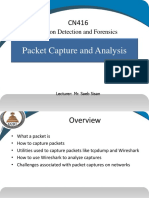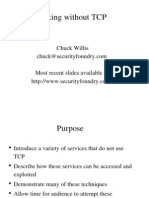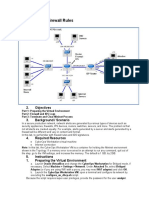Diadem - FPGA
Diadem - FPGA
Uploaded by
Chien DoMinhCopyright:
Available Formats
Diadem - FPGA
Diadem - FPGA
Uploaded by
Chien DoMinhOriginal Description:
Copyright
Available Formats
Share this document
Did you find this document useful?
Is this content inappropriate?
Copyright:
Available Formats
Diadem - FPGA
Diadem - FPGA
Uploaded by
Chien DoMinhCopyright:
Available Formats
FPGA Network Firewalling
David Thomas
Outline
The Diadem firewall project
Role of FPGAs within Diadem
The IBM FPGA Firewall
Primary Goals
Progress
The Diadem Project
Funded by the EU (your tax Euros at work)
Nine partners
Four academic
Three industrial
Five countries
France, Germany, Slovenia, UK, Poland
Three year project, 6 months left
Diadem Goals
Create a firewall that uses distributed
elements within networks to detect and
respond to attacks
Monitoring elements detect attacks in progress
Policy elements decide how to react to attacks
Firewall elements put reaction policy into effect
Target areas are large organisations or ISPs
with many peering points to foreign
networks
Example network architecture
Untrusted
Network
Edge Router
Firewall
Protected
Network
Edge Router
Firewall
Untrusted
Network
Protected
Servers
Diadem network architecture
Untrusted
Network
Edge Router
Firewall
Protected
Network
Edge Router
Firewall
Untrusted
Network
Monitoring
Element
Monitoring
Element
Secure
Operator Network
Firewall
Element
Firewall
Element
Policy
Manager
Protected
Servers
Example : SYN flood attack (1)
TCP uses three way handshaking:
1. client -> server : SYN
2. client <- server : SYN, ACK alloc state
3. client -> server : ACK established
Between steps 2 and 3 server must maintain
state, using system memory
Memory can only be released after a timeout.
After memory is used up no new connections
can be established
Example : SYN flood attack (2)
Attacker uses zombies to spoof source addresses
Zombies continually perform steps 1 but never
send packet 3
1. fake_ip1 -> server : SYN
2. fake_ip1 <- server : SYN,ACK backlog=1
3. fake_ip2 -> server : SYN
4. fake_ip2 <- server : SYN,ACK backlog=2
Server backlog keeps growing until no new
connections can be established
Example : SYN flood response
Use firewall between clients and server to screen
new connections
1. client->fwall:SYN
2. client<-fwall:SYN,ACK (using cookie)
3. client->fwall:ACK (client added to whitelist)
4. client<-fwall:RST (connection dropped)
5. client->fwall->server:SYN (client now on whitelist)
6. client<-fwall<-server:SYN,ACK
7. client->fwall->server:ACK (connection established)
Diadem network architecture
Untrusted
Network
Edge Router
Firewall
Protected
Network
Edge Router
Firewall
Untrusted
Network
Monitoring
Element
Monitoring
Element
Secure
Operator Network
Firewall
Element
Firewall
Element
Policy
Manager
Protected
Servers
Accelerated network architecture
Untrusted
Network
Edge Router
Protected
Network
Edge Router
Untrusted
Network
Monitoring
Element
Monitoring
Element
Secure
Operator Network
Firewall
Element
Firewall
Element
Policy
Manager
Protected
Servers
The IBM FPGA Firewall (1)
IBM (one of the partners) have created a hardware
accelerated firewall
Uses a host PC and a PCI FPGA card
Host PC reads packets from network and extracts
packet headers
srcIp,dstIp,srcPort,dstPort,flags : ~ 100 bits
FPGA does packet classification: looks at packet
headers supplied by host and determines correct action
(accept, reject, log etc.)
Host PC applies appropriate action to packet and sends
it back to network
The FPGA only does packet classification
The IBM FPGA Firewall (2)
Theyve had some problems
They use weird FPGA boards with no support
Theyre talking to the FPGA in kernel mode!
The number of rules they can apply is limited by the
amount of TCAM they can instantiate
TCAMs use SRL16s, not block RAMs
No expertise in FPGAs
There is a bottleneck on the PC side
It is difficult to process gigabit streams in software,
even when packet classification is done in hardware
Enter Imperial
What IC brings to the table
We have RC300s: full duplex Gb ethernet
We know a lot about FPGAs
We dont take three hours for lunch
Our goal: a standalone FPGA firewall
Performs the functionality of IBM firewall
Uses the same API as the IBM firewall
Operates at high data and packet rates
Current Platform: RC300
Virtex-II xc2v600 FPGA
6 M Gates (33K Slices)
2.6 MBits of embedded RAM
Intel IXF1104 MAC
Two full duplex 1Gb ethernet ports
Exposed to FPGA as two 8-bit streams at 125MHz
Samsung ZBT SRAM
4MB of 36 bit wide RAM @ 117MHz
Four independent banks
ZBT: can interleave reads and writes at full speed
Firewall Model
Firewall
Element
Router
Intranet
RC300
Firewall Device
Table updates sent
via network
Table updates sent
over USB
Internet
Router
System
Manager
Rule changes sent to
firewall element
Rule changes translated
into updates for firewalls
internal tables
Assumptions
The firewall does not need to be very clever
Rules are translated into tables elsewhere
Updates are sent to the firewall as binary patches to be
applied to internal tables (as UDP packets or over USB)
The firewall does not need to maintain state
No support for packet fragmentation/assembly
No need to recognise packets as part of a stream
The firewall is connected to a single endpoint at
each port
Only needs to know two Ethernet MACs, no ARP
The set of firewall responses is very simple
Classification
Classifications is performed on a subset of packet
header info
Source and destination IP address (2x32 bits)
Source and destination ports (2x16 bits)
Miscellaneous flags/protocol type (~12 bits)
Rules specify list of rules in order or priority
Dest=server:80, src=?:?, Protocol=TCP Accept
Dest=server:?, src=?:?, Protocol=? Reject
Classifier needs to find the first matching rule
within the list
Responses
Basic
Accept, Reject
Redirect (patch IP dest for inward, source for outward)
Log (Envelope packet info and send to an IP)
Reply with error
Throttling (random drop)
Simple combinations of above
Possible
Throttling (limit to specified rate)
SYN flood protection
Statistics gathering
Firewall Architecture
RC300
ZBT RAM
ZBT RAM
Classifier Processor
Classifier Processor
Port 0
MBlaze
USB
Classifier
Router
Router
Processor
Classifier Processor
Classifier Processor
Processor Classifier
Port 1
BRAMs
BRAMs
BRAMs
ZBT RAM DDR RAM
Bulk storage for things like
half-open connections Fast storage for table
overflow
USB comms
route to host
Network comms
route to host
Crypto
support
Integration
Acts as simple front-end firewall
Acts as a high-speed barrier when under attack
Will still require existing IBM firewall behind it to
apply more complex rules (e.g. content inspection)
Can implement same API as existing IBM firewall
API implemented on Linux host
Host translates API calls into table updates and
forwards them to the RC300 over Ethernet or USB
May only support a subset of functionality
Progress
Basic firewall is working
Support up to 1024 rules (IBM does 256)
Support up to 17.5 Mpackets/s
Up to 800 Gb/s
Limited by the Celoxica PSL
Currently working on integration with
Diadem API
Summary
Diadem firewall project
Distributed firewall to respond to distributed
attacks
FPGAs used within the firewall for speed
Initial implementation currently running on
the RC300
You might also like
- Network Security All-in-one: ASA Firepower WSA Umbrella VPN ISE Layer 2 SecurityFrom EverandNetwork Security All-in-one: ASA Firepower WSA Umbrella VPN ISE Layer 2 SecurityNo ratings yet
- MHENDERSON SettingThePaceDocument56 pagesMHENDERSON SettingThePaceshubham kansalNo ratings yet
- FirewallsDocument5 pagesFirewallsUma Maheswara RaoNo ratings yet
- Computer Security - Lec 7 - Intrusion Prevention SystemsDocument39 pagesComputer Security - Lec 7 - Intrusion Prevention SystemsAntonio pNo ratings yet
- Switch and Router ConfigurationDocument41 pagesSwitch and Router ConfigurationBroot KalNo ratings yet
- DEFCON 19 Duckwall Bridge Too Far PDFDocument121 pagesDEFCON 19 Duckwall Bridge Too Far PDFMiguel ChaparroNo ratings yet
- Traffic PDFDocument162 pagesTraffic PDFSenan Alkaaby100% (4)
- 491s Lec8 FirewallsDocument37 pages491s Lec8 FirewallsKalsoom TahirNo ratings yet
- Chapter 6: Securing The Local Area NetworkDocument116 pagesChapter 6: Securing The Local Area NetworkRyanb378No ratings yet
- Project: Evaluating SNMP Application Level Gateway (SNMP Alg)Document16 pagesProject: Evaluating SNMP Application Level Gateway (SNMP Alg)Ramu AlagappanNo ratings yet
- GregSowell Mikrotik SecurityDocument22 pagesGregSowell Mikrotik SecurityMarco Vinicio Rojas GarciaNo ratings yet
- Cisco CCNA - Last Minute Revision: CCNA Certification Study GuideDocument5 pagesCisco CCNA - Last Minute Revision: CCNA Certification Study GuideGold SunriseNo ratings yet
- 10 7 Firewalls InkDocument14 pages10 7 Firewalls InkamjadsadozaiNo ratings yet
- MB-6 Introduction To WiFi Security and Aircrack-NgDocument76 pagesMB-6 Introduction To WiFi Security and Aircrack-NgOsvaldo González DíazNo ratings yet
- Ch09 (Firewalls)Document27 pagesCh09 (Firewalls)vamshipriyastorage1No ratings yet
- Firewalls: CS-455 Dick SteflikDocument24 pagesFirewalls: CS-455 Dick SteflikAkash PatelNo ratings yet
- Firewall S: Pankaj Singh 04EC41 Nitk SurathkalDocument22 pagesFirewall S: Pankaj Singh 04EC41 Nitk SurathkaldannyzarNo ratings yet
- Stateful FirewallsDocument30 pagesStateful FirewallsSurajKumarNo ratings yet
- Firewall Design and ManagementDocument55 pagesFirewall Design and ManagementWajeeh RathoreNo ratings yet
- Networking Basics Notes - v2Document45 pagesNetworking Basics Notes - v2Gherasa Marius BogdanNo ratings yet
- Trans ProxyDocument44 pagesTrans ProxyJuan Gonzales VillacortaNo ratings yet
- DNS, DHCP, SNMP & Network SecurityDocument22 pagesDNS, DHCP, SNMP & Network SecurityArun PatelNo ratings yet
- Firewall: Ir. Risanuri Hidayat, M.Sc. Teknik Elektro FT UGMDocument30 pagesFirewall: Ir. Risanuri Hidayat, M.Sc. Teknik Elektro FT UGMRain Mika AlexandriaNo ratings yet
- Introduction To SRX-series Services Gateways: Proprietary and ConfidentialDocument27 pagesIntroduction To SRX-series Services Gateways: Proprietary and ConfidentialmafcokNo ratings yet
- FirewallsDocument60 pagesFirewallsXozanNo ratings yet
- Cisco Device and Network ManagementDocument25 pagesCisco Device and Network ManagementVadi VelanNo ratings yet
- Firewalls: BY K.Badarinath 08131A1216Document25 pagesFirewalls: BY K.Badarinath 08131A1216kedarr_1224100% (1)
- Cs 164: Slide Set 12 Ipv6 and Transport LayerDocument34 pagesCs 164: Slide Set 12 Ipv6 and Transport LayersinanPass3401No ratings yet
- Examples Peer-To-Peer Applications: (Gnutella, Kazaa, Bittorrent, Skype)Document27 pagesExamples Peer-To-Peer Applications: (Gnutella, Kazaa, Bittorrent, Skype)sonaaa_777No ratings yet
- Mikrotik y MduDocument23 pagesMikrotik y MduMarco Antonio Martinez AndradeNo ratings yet
- CN 422-Week#3 Lect-Packet Capture and AnalysisDocument31 pagesCN 422-Week#3 Lect-Packet Capture and AnalysisITtickeiNo ratings yet
- Comm Dev 2007Document24 pagesComm Dev 2007Norman StreetNo ratings yet
- Traffic PDFDocument162 pagesTraffic PDFpeka76No ratings yet
- Firewalls: CS 772 Fall 2009Document19 pagesFirewalls: CS 772 Fall 2009XozanNo ratings yet
- Presentation 4440 1497864745Document61 pagesPresentation 4440 1497864745MBK CommunicationsNo ratings yet
- Project - Mtcna m6 Firewall en V1.keyDocument55 pagesProject - Mtcna m6 Firewall en V1.keyIbadNo ratings yet
- SNMPDocument31 pagesSNMPsaikat_bandyopadhyayNo ratings yet
- SNMPDocument31 pagesSNMPAstri MayasariNo ratings yet
- En CCNAS v11 Ch06Document117 pagesEn CCNAS v11 Ch06Joseph EdwardsNo ratings yet
- SNMPDocument31 pagesSNMPjeevasakthiNo ratings yet
- Module 6s - Networking Rev2Document44 pagesModule 6s - Networking Rev2Ara SunuNo ratings yet
- Unit - 4 Remaining TopicsDocument87 pagesUnit - 4 Remaining TopicsNivedhithaNo ratings yet
- 14-Module-3 Notes-14-03-2024Document32 pages14-Module-3 Notes-14-03-2024Soham BandyopadhyayNo ratings yet
- DEFCON 18 Blake Bitemytaco Hacking DOCSISDocument32 pagesDEFCON 18 Blake Bitemytaco Hacking DOCSISCristoNo ratings yet
- Chapter 5 - Auditing Switches, Routers, and FirewallsDocument26 pagesChapter 5 - Auditing Switches, Routers, and FirewallstwallerstedtNo ratings yet
- Ccna Bootcamp: Wide Area Networks (Wans)Document8 pagesCcna Bootcamp: Wide Area Networks (Wans)ynot666No ratings yet
- Development of A Pcie Dma Engine Verification Framework: Michal Husejko Eda - Support@Cern - CHDocument20 pagesDevelopment of A Pcie Dma Engine Verification Framework: Michal Husejko Eda - Support@Cern - CHsvenka3No ratings yet
- Hacking Without TCP SlidesDocument88 pagesHacking Without TCP SlidesMrityunjay SharmaNo ratings yet
- Firewalls: Network SecurityDocument7 pagesFirewalls: Network SecurityRashmiDeshmukhNo ratings yet
- Wireless Networking With IEEE 802.15.4 and 6LoWPANDocument60 pagesWireless Networking With IEEE 802.15.4 and 6LoWPANJohn PaulNo ratings yet
- 26.1.7lab - Snort and Firewall RulesDocument7 pages26.1.7lab - Snort and Firewall RulesThái NguyễnNo ratings yet
- Team 2 Summay Module 1-4Document7 pagesTeam 2 Summay Module 1-4Yeng VisalNo ratings yet
- Introduction To IP Multicast PDFDocument121 pagesIntroduction To IP Multicast PDFHieuNBNo ratings yet
- Networking For Offensive Security TCPDocument87 pagesNetworking For Offensive Security TCPlefreak1979100% (2)
- Cisco Certified Network Associate CCNADocument177 pagesCisco Certified Network Associate CCNAJakayla41No ratings yet
- Sparkasse - PrezentacijaDocument112 pagesSparkasse - PrezentacijaAdnan SulejmanovicNo ratings yet
- Ipchains Iptables FirewallDocument39 pagesIpchains Iptables FirewallGalih YogiNo ratings yet
- Snort - A Network Intrusion Prevention and Detection SystemDocument65 pagesSnort - A Network Intrusion Prevention and Detection SystemNAINA AGRAWALNo ratings yet
- Lec02-Vulnerabilities in IPDocument113 pagesLec02-Vulnerabilities in IPshahzadkhanafridiNo ratings yet
- PLC: Programmable Logic Controller – Arktika.: EXPERIMENTAL PRODUCT BASED ON CPLD.From EverandPLC: Programmable Logic Controller – Arktika.: EXPERIMENTAL PRODUCT BASED ON CPLD.No ratings yet
- Accessing Class Member ExampleDocument24 pagesAccessing Class Member Examplevidhya associateNo ratings yet
- Baggage InformationDocument19 pagesBaggage InformationJrNo ratings yet
- SDTM FSP RFP - 8nov2018Document21 pagesSDTM FSP RFP - 8nov2018Martijn Van MechelenNo ratings yet
- DEFCON 26 Alex Levinson Overview of Genesis Scripting EngineDocument49 pagesDEFCON 26 Alex Levinson Overview of Genesis Scripting EngineMitchNo ratings yet
- Author:Alastair Endersby (United Kingdom) Alastair Learnt To Debate at The Cambridge UnionDocument3 pagesAuthor:Alastair Endersby (United Kingdom) Alastair Learnt To Debate at The Cambridge Unionstefan133No ratings yet
- SFT 02 01380Document1 pageSFT 02 01380Bibhudutta MishraNo ratings yet
- CMPT 300: Operating Systems I CH 6: Process SynchronizationDocument48 pagesCMPT 300: Operating Systems I CH 6: Process SynchronizationAnzar ImamNo ratings yet
- Introduction To E-CommerceDocument55 pagesIntroduction To E-CommerceManjunath goudaNo ratings yet
- Bosch Edc Indracontrol l40 2007 ManualDocument130 pagesBosch Edc Indracontrol l40 2007 ManualOmar FÜentesNo ratings yet
- FOM Solved ManualDocument97 pagesFOM Solved ManualNaveen Prabhu40% (5)
- Handy TesterDocument10 pagesHandy TesterguillermomolteniNo ratings yet
- JIGYASUDocument72 pagesJIGYASUjigyashu singhNo ratings yet
- JL-92-July-August Design and Construction of Spliced I-Girder BridgesDocument9 pagesJL-92-July-August Design and Construction of Spliced I-Girder BridgesRammiris ManNo ratings yet
- File ListDocument3 pagesFile ListpriszeroNo ratings yet
- Spare Parts Catalogue: Hydraulic Drilling RigDocument53 pagesSpare Parts Catalogue: Hydraulic Drilling RigJavier Perez ReyesNo ratings yet
- Dishpointer Satélite Amazonas - SBSDocument5 pagesDishpointer Satélite Amazonas - SBSLuis Daniel Woiski GuilhermeNo ratings yet
- CSEC Information Technology January 2017 P032Document13 pagesCSEC Information Technology January 2017 P032Jhanett RobinsonNo ratings yet
- Questions 1-5. Complete The Form Below Using NO MORE THAN THREE WORDS AND / OR NUMBERSDocument11 pagesQuestions 1-5. Complete The Form Below Using NO MORE THAN THREE WORDS AND / OR NUMBERSĐình KhánhNo ratings yet
- Bouc Wen Simulink ModelDocument18 pagesBouc Wen Simulink Modelajd.nanthakumarNo ratings yet
- Programmable Peripheral Interface - PPI (8255)Document18 pagesProgrammable Peripheral Interface - PPI (8255)Roshan VaradharajanNo ratings yet
- EX Configs ALLDocument1,076 pagesEX Configs ALLum@gNo ratings yet
- OSI Model: CybersecurityDocument14 pagesOSI Model: CybersecurityAadithyaNo ratings yet
- About Us: 20,000/-From Each Candidate. There Are Only Limited Seats Available. InterestedDocument3 pagesAbout Us: 20,000/-From Each Candidate. There Are Only Limited Seats Available. Interestedkabilkumar ANo ratings yet
- CC 303-WB OD Fall 2017 SyllabusDocument8 pagesCC 303-WB OD Fall 2017 SyllabusBlake SteinesNo ratings yet
- S.S.3 QuestionsDocument6 pagesS.S.3 Questionsangus ogwucheNo ratings yet
- EE6601 NotesDocument112 pagesEE6601 NotesKishoreNo ratings yet
- PTJEL CJP QAQC WPP 002 Rev 5 - Document Control ProcedureDocument9 pagesPTJEL CJP QAQC WPP 002 Rev 5 - Document Control ProcedureBumi AzarakhNo ratings yet
- Building An iOS App - A Step-by-Step TutorialDocument3 pagesBuilding An iOS App - A Step-by-Step Tutorialnabila danish0% (1)
- EKO 7 v1.02.00 EDocument402 pagesEKO 7 v1.02.00 ETony KututoNo ratings yet

























































































